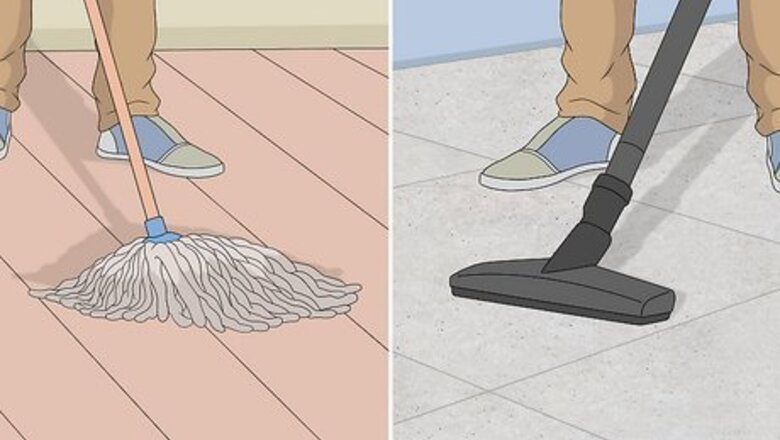
views
- Use a brush to apply polyurethane to flat surfaces, a rag for contoured surfaces, and aerosol spray for hard-to-reach areas.
- Sand the wood before applying polyurethane to create a smooth surface. Be sure to wipe away any remaining dust.
- Wait for each coat of polyurethane to dry before applying the next. Sand the wood between coats, as well.
Prep Work
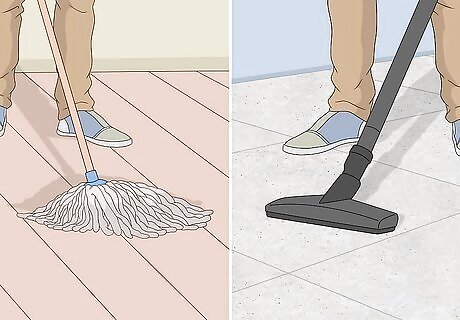
Set up and clean your workspace. Choose a well-ventilated room or area to work in, then vacuum, mop, and wipe down every surface to help keep particles from sticking to your coats of polyurethane. Lay down a protective covering (like a tarp, dropcloth, or cardboard) to protect the surface beneath your project and the surrounding area. To create a cross-breeze, open a window and install an exhaust fan facing outward. Then, if possible, open a window on the opposite side of the room. Never place a fan in your immediate work area to avoid blowing dust onto the wood. Purchase a respirator with an organic cartridge if you are unable to improve the room’s ventilation and/or if you are sensitive to fumes. Make sure your protective covering is a few feet longer than your project to fully protect the surrounding area. Remove any objects that you want to keep clean in case you make a bigger mess than you mean to.
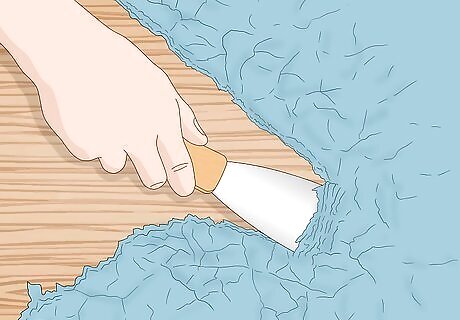
Remove old finishes from the wood. Strip the wood of any preexisting shellac, lacquer, wax, varnish, or paint. Apply a paint stripper for large areas, and use a scraper for small sections. If possible, work outdoors for better air circulation and to make the clean-up process easier. If you can’t work outside, wear a professional-grade ventilator mask.
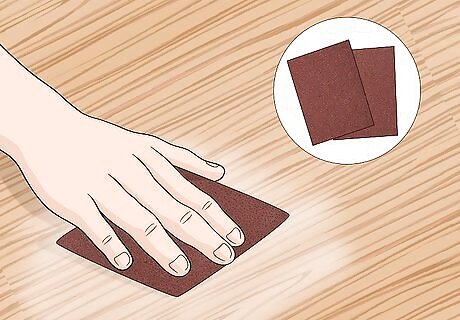
Sand the wood. Start with a medium (100-grit) sandpaper if the wood feels especially rough. After that, resand it with fine (150-grit) sandpaper, and then again with extra-fine (220-grit) paper. Inspect the wood for any scratches in between each sanding. If necessary, use the extra-fine paper to smooth scratched areas.
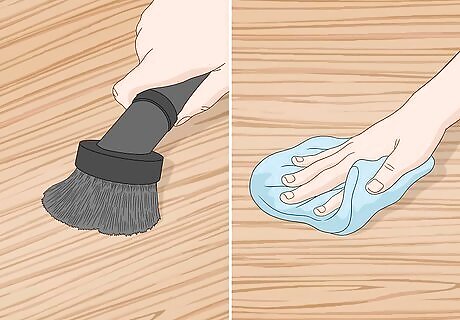
Vacuum and wipe away all dust and debris. Vacuum the wood and surrounding area to remove all of the dust created by sanding. Use a soft-brush attachment when vacuuming the wood itself to avoid scratching the surface. Then dampen a lint-free cloth and wipe the wood down to remove any dust that the vacuum missed. Repeat with a second wipe-down using a dry microfiber cloth. If your polyurethane is oil-based, use mineral spirits to dampen your lint-free cloth. Wear nitrile gloves and a respirator when handling mineral spirits. For water-based polyurethane, dampen your cloth with water. Some people use tack cloths for the dry wipe-down, but be aware that some tack cloths may include chemicals that will interfere with the polyurethane’s adhesion.
Applying Polyurethane
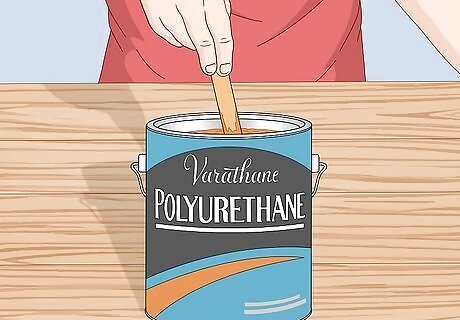
Stir the polyurethane. After you open the can, use a stir stick to evenly mix the polyurethane’s components, which may have settled and separated over time. Never shake the polyurethane, as shaking can create bubbles in the liquid, which may be transferred intact to the wood, creating an uneven coat.

Seal the wood using a mix of polyurethane and mineral spirits. Use a clean container to create a mixture of polyurethane and mineral spirits. Combine two parts polyurethane with one part mineral spirits in the new container. Brush or wipe a single coat of this mixture onto the wood. Sealing the wood with mineral spirits and polyurethane helps the first coat of pure polyurethane go on more easily. Wait for it to dry before proceeding. Pure polyurethane takes roughly 24 hours to dry, but it should take less than that when diluted with mineral spirits. Mineral spirits can cause chemical burns and have strong fumes, so always wear protective gear when handling them. Protect your hands with nitrile gloves, cover your eyes with goggles, and wear a respirator to avoid breathing in fumes.

Wet sand the wood. From this point forward, always sand the wood before applying a new coat. Dip the sandpaper in water and sand in circular motions. Remove any runs, drips, bubbles, or visible brushstrokes that may have developed. Use extra-fine (220-grit) sandpaper to reduce the chance of scratching the surface. Once done, vacuum and wipe the wood again to remove all particles.

Apply the first coat of pure polyurethane. After sealing the wood, apply pure polyurethane using a brush, a rag, or an aerosol spray. Pour small batches of the polyurethane into a clean container rather than dipping your brush or cloth directly into the original can. This helps you avoid tainting your main supply with any dust or other particles that your brush or cloth might pick up. Use a brush on flat surfaces to cover large areas. Dip the brush about an inch (2.5 cm) into the polyurethane to coat it, then brush with the grain in long, even strokes. After each stroke, run the brush back over any drips to smooth them out. Use a brush with natural bristles for oil-based polyurethane and synthetic bristles for water-based. Wipe contoured and uneven surfaces with a rag to avoid drips from brushing. Fold the rag into a palm-sized square and dip the edge into the polyurethane. Wipe it onto the wood, following the grain. Overlap half of the previous wipe for even coating. This technique creates thinner coats, so you’ll probably need double the amount of coats you’d use when brushing. Spray hard-to-reach areas with an aerosol can. Spray in short bursts to avoid creating drips, since these will also be out of reach and difficult to repair. Cover surrounding areas with a protective surface before applying, and practice on a test area to improve your technique.

Repeat the coating and sanding process. Once the first coat has dried (about 24 hours), sand the wood again. Then add a second coat in the same manner. Wait another 24 hours to dry. If you used a brush, two coats are enough. For any areas where you used a cloth or spray, repeat twice for a total of four coats. After the final coat use a piece of cardboard instead of sandpaper to buff the surface to create a nice finish.
Choosing a Polyurethane
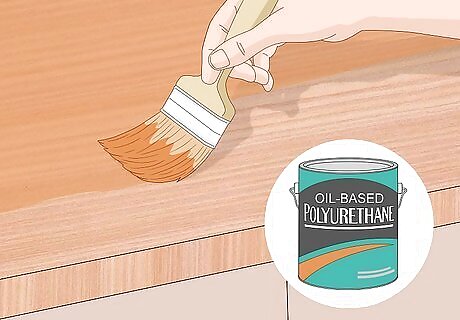
Use an oil-based polyurethane for surfaces exposed to heat. Oil-based polyurethane is more durable than water-based, so it works well on surfaces like countertops or kitchen tables. It has a stronger odor and a slower drying time than water-based, however, and tends to develop an amber tint over time.
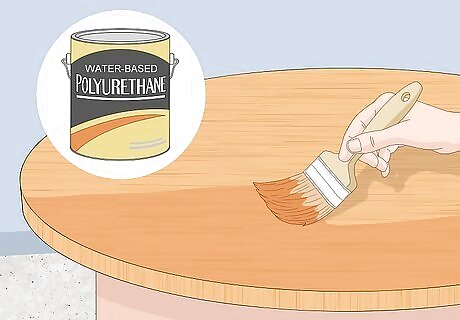
Use a water-based polyurethane for surfaces that aren’t exposed to the elements. Water-based polyurethane has a low odor and a quick drying time, but it doesn’t handle heat as well as oil-based and may require more coats. Use it for projects like end tables, desks, and bookshelves.
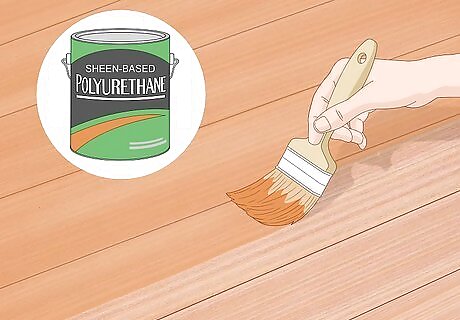
Select a sheen based on your preference. Flat, or matte, polyurethane is the least shiny and looks the most like natural wood, so it’s a good choice for furniture. Satin polyurethane has a low-to-medium sheen that conceals dirt and scratches, so it’s a good option for flooring. Semi-gloss and gloss polyurethane are the most reflective finishes and are great for cabinets and picture frames.













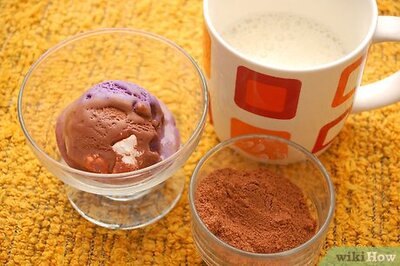

Comments
0 comment